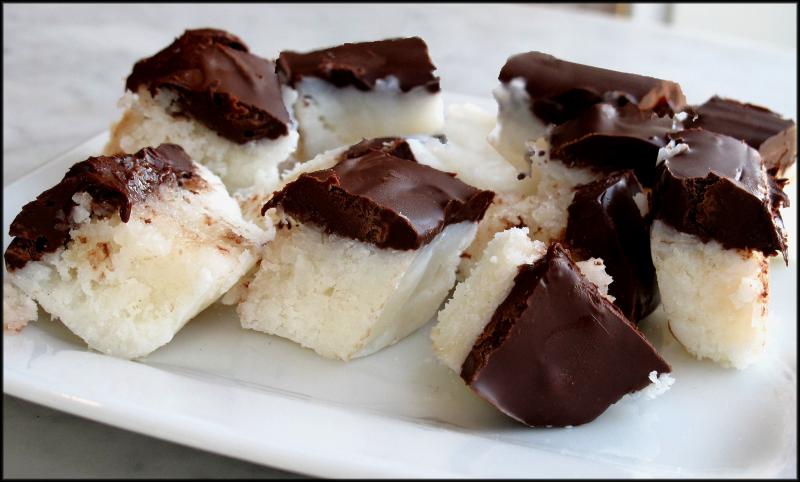What’s the deal with coconut oil?
Over the past few weeks, several people have asked me about coconut oil, so here I’ll offer an introduction to those of you who may not be familiar with it. To begin, coconut oil doesn’t look like most oils. At room temperature in your pantry or on the market shelf in its glass jars, coconut oil is a shiny white solid, not a liquid.
Most recipes that call for coconut oil start with instructions to melt the oil before mixing it with other ingredients. Like everything else, there are different kinds of coconut oils, with a range of qualities, including non-GMO, organic, refined and fractionated.
The health benefits of coconut oil have been widely debated. Some proponents cite studies indicating its value as a skincare treatment and scalp soother, while others advocate coconut oil as a better fat than butter or olive oil, with properties that can aid digestion and promote immune function.
For each coconut oil advocate, there is someone with an opposing point of view, but some basic things are true. Every edible oil - palm, coconut, olive, safflower, canola - is a highly processed, high-calorie food. All oils are a source of dense calories and if included in the diet should be used in moderation.
Where did all this interest in coconut come from? It seems to have originated almost 10 years ago, when coconut water emerged as a popular low-calorie, electrolyte-rich hydration beverage, especially in the sports-drink market. At about 50 calories per cup, more potassium than a banana and helpful levels of magnesium, coconut water is a good pre- or post-workout beverage.
I can just imagine how this came to the market. Someone on vacation saw a street vendor in a tropical setting cut the top off a green coconut, insert a straw and sell tourists coconut water still in the shell. The water has a delicate flavor, slight whitish color and offers ideal refreshment on a sunny day.
Once coconut water gained notice, other coconut products became more widely available at the market. Coconut milk is a rich liquid typically found as an ingredient in curries and Thai dishes. It’s made from coconut pulp that has been pureed with water and then strained.
Coconut cream has a paste-like consistency similar to sweetened condensed milk and is a more concentrated form of coconut milk. This is often called for as an ingredient in sweet desserts such as coconut pudding or Pina Colada cocktails.
Coconut oil - which is where we started - can be used in place of olive oil or butter when making most dishes that call for oil, from scrambled eggs to stir-fried vegetables. Because of its solid state at room temperature, some enthusiasts spread it on toast or stir it into their coffee.
We try to use as little oil as possible when we cook, so I thought I’d experiment with coconut oil as an ingredient in a dark chocolate bar. As you may know, the fat content in a chocolate bar comes primarily from cocoa butter and the rich flavor comes from the cocoa solids (assuming a low-sugar dark bar).
Since cocoa powder is 90 percent cocoa solids and has very little cocoa butter, you can make a chocolate bar by mixing coconut oil with cocoa powder and a splash of vanilla extract. I elected not to share my photos of this experiment, as the result was far too free-form. As instructed in the recipe here, pouring the mixture into a small pan will allow it to reach a reasonable and more-desirable thickness resembling an actual bar.
My next experiment was for Jack, who loves coconut. As you can see in the photo, we have a version of the chocolate-coconut candy sold commercially (and more perfectly formed) as a Mounds Bar. I mixed sweetened shredded coconut flakes with coconut oil into a smooth paste and spread it in a pan. Once this layer had frozen solid, I poured on a chocolate topping and chilled it further. We will definitely need to practice moderation here.
Chocolate-Topped Coconut Bars
1/2 C coconut oil
2 C coconut flakes
2 T honey*
1/2 C semi-sweet chocolate
Line a 6-by-6-inch pan with aluminum foil; set aside. Place the coconut oil in a microwave-safe bowl and heat until melted, about 30 seconds on high. Add coconut flakes and stir until combined. Add honey, if using.
With an immersion blender, process the mixture until smooth. Spread coconut mixture evenly across the bottom of the prepared pan. Place in the freezer for 20 minutes. Place chocolate in a glass measuring cup and heat in the microwave on low power until melted. Remove pan from freezer and pour chocolate over the coconut. Return pan to freezer and allow to solidify before cutting into pieces, about 1 hour. Store in a tightly covered container in the refrigerator. *Note: if using sweetened coconut flakes, omit honey.
Chocolate Bars
1/2 C coconut oil
2/3 C dark cocoa powder
1/3 C honey
1/2 t vanilla extract
pinch of salt
Line a 6-by-6-inch pan with parchment paper; set aside. Melt coconut oil in a small saucepan over low heat. Stir in remaining ingredients, mixing until completely smooth. Pour into prepared pan and refrigerate until set, about 3 hours. Slice or break into pieces. Store in a tightly covered container in the refrigerator.























































